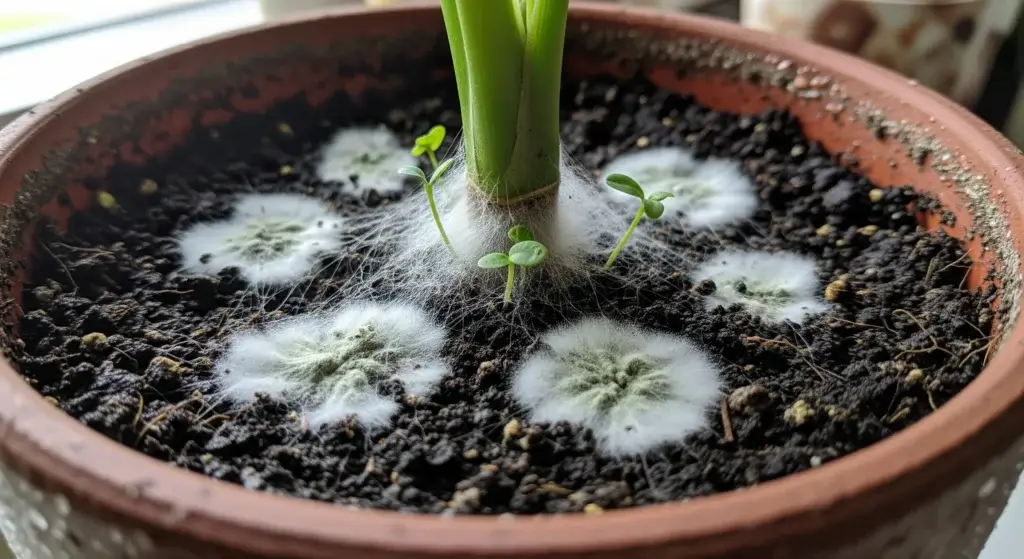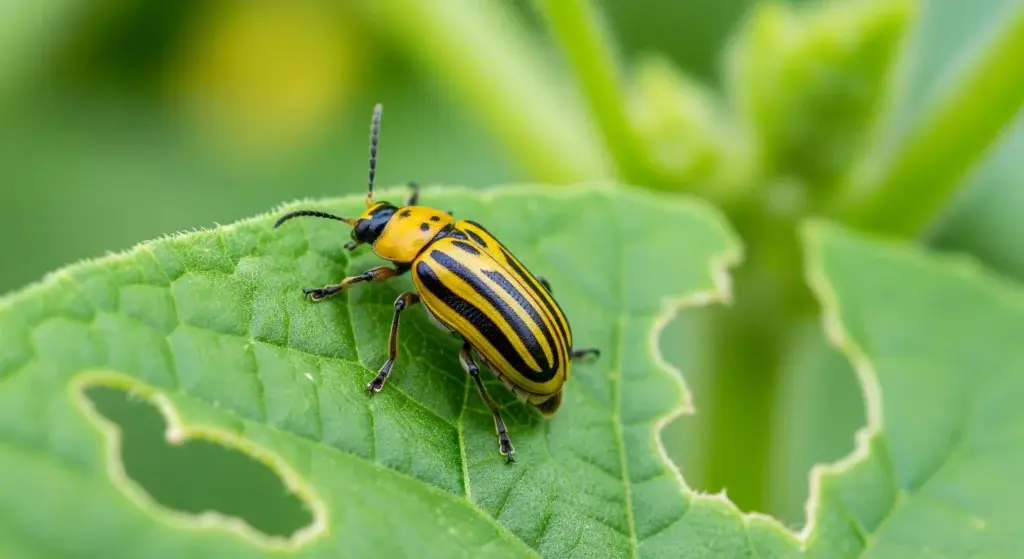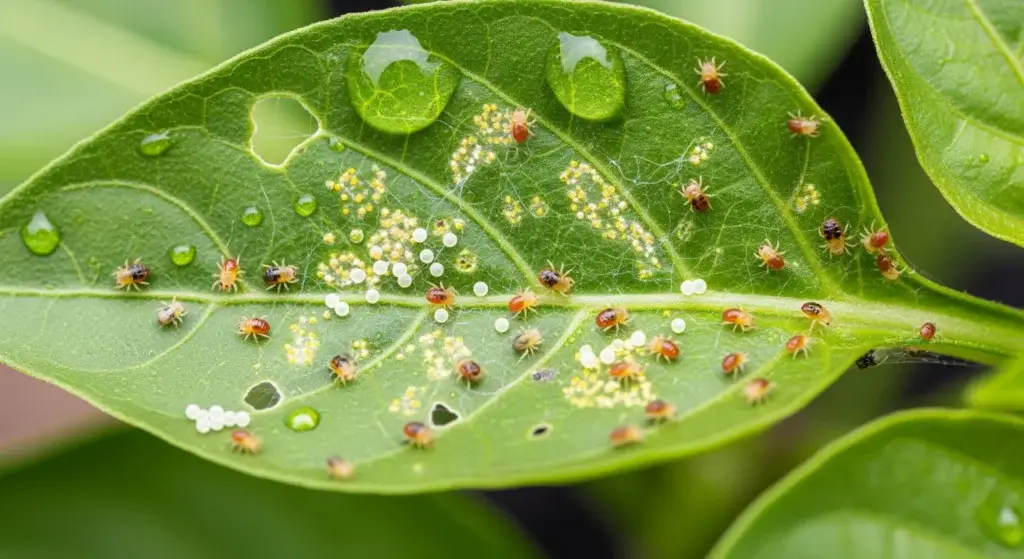
If you’ve ever looked at your houseplant and thought, “Why does my soil look like it’s growing a beard?” — don’t panic.
That fuzzy white or gray stuff is just mold, and guess what? It’s way more common than you think.
From cacti to monsteras, every plant parent faces it at some point.
The good news? It’s usually harmless — your plant’s not doomed.
In this guide, we’ll break down how to kick mold out of your soil, keep it from coming back, and make your plants thrive like the leafy legends they are.
Understanding What That White Fuzzy Stuff Actually Is
So, that mysterious white fuzz on your plant’s soil? It’s not alien life—just saprophytic fungus, basically the cleanup crew of nature.
It feeds on dead stuff in your potting mix, not your plant, so relax—your green baby’s safe.
Watch for yellow slime mold-it really does look like someone dropped a dollop of mustard on the soil.
You may also see small mushrooms emerging.
These weird little visitors love wet soil and sticky, humid air.
It’s like a mold party out there when the weather gets like that.
Most of the time, they don’t bother your plants, but if you or anyone around has allergies or asthma, they can be a real pain.
So don’t just let the fuzzy stuff slide; it is worth checking in and cleaning it up when you find it.
Why Mold Keeps Appearing on Your Plant Soil
If mold keeps popping up like it pays rent, trust me, your plant’s not just being extra.
Nine times outta ten, it’s your care routine basically rolling out the red carpet for those spores. So, what’s really happening here?
Overwatering
Classic rookie move. If you’re drenching that soil on a strict schedule just because the calendar says so, you’re basically throwing a rave for fungi.
Plants don’t give a rip about what day it is.
They want what they want: dry feet before another drink.
So, maybe poke a finger in the dirt first, yeah?
Poor Air Circulation
Got your plant shoved in some forgotten corner where the air’s deader than disco? That’s mold heaven.
Stale, moist air is literally what they dream about at night. It’s like tossing your gym socks in a ziplock and leaving them under your bed—disgusting things happen.
Crack a window, fire up a little fan, let the air move. Your plants (and honestly, your own nose) will appreciate it.
Low Light Conditions
Plants in dim corners don’t use up much water because they’re barely photosynthesizing.
That leftover moisture in the soil? Perfect mold soup.
Move your plant where it can catch some rays—think “bright but not sunburn-level.”
Organic-Rich Potting Mixes
Soil packed with stuff like peat moss or compost is a five-star buffet for fungi.
Don’t get me wrong—it’s great for plant nutrition, but also great for mold spores just waiting for the right moment to wake up.
High Humidity Levels
When the air’s super damp—like over 60%—mold feels right at home.
Combine that with low airflow and cool temps, and you’ve got yourself a fungal rave.
Balance your humidity so your plants thrive but mold doesn’t move in rent-free.
Immediate Steps to Remove Existing Mold
Spot mold on your plant soil? Time to suit up and go into cleanup mode.
You don’t need a hazmat suit, just a little patience and a plan. Here’s how to kick that fuzzy intruder out for good.
Remove Visible Mold Growth
First thing—get rid of the gross stuff.
Gently scrape off the top inch or two of moldy soil using a spoon or something you won’t use for cereal later.
Don’t toss it in the compost; bag it up and throw it out. Composting mold is like inviting it to infect all your other plants—it’ll gladly accept.
Treat the Remaining Soil
Now, it’s time to disinfect the scene. You’ve got a few cool, low-key science experiments to pick from:
Natural antifungal spray:
Mix a tablespoon of baking soda with a quart of water and a few drops of liquid soap.
Spray it over the soil like you’re blessing it. The baking soda changes the soil’s pH just enough to make mold go, “nope.”
Cinnamon powder:
Sprinkle it like fairy dust. Not only does it smell amazing, but cinnamon also kills fungus. (Yes, your kitchen spice rack just became a first-aid kit for plants.)
Hydrogen peroxide solution:
Mix one part 3% hydrogen peroxide with four parts water and use it to water your plant.
It kills mold spores and gives your plant’s roots a nice oxygen boost—like a mini spa treatment.
Replace the Top Layer
After treatment, top off your plant with fresh soil.
Mix in some perlite or coarse sand for better drainage—basically giving your plant’s roots a breathable upgrade.
Want bonus points? Add a thin layer of pebbles or gravel on top to keep the surface dry and unappealing to mold.
Ensure Proper Drying Time
Now, hands off that watering can. Let the soil dry out more than usual before watering again.
Stick your finger a couple inches deep—if it’s still damp, chill for another day or two. Mold hates dryness, so you’re basically starving it out.
Long-Term Prevention Strategies for Mold-Free Plants
Keep mold away for good by tweaking how you care for your plants — small moves, big payoff.
Perfect Your Watering Technique
Only water when the top 1–2 inches of soil feels dry.
Use the finger test, a moisture meter, or lift the pot — wet soil is heavy.
When you water, do it until water drains, then dump the tray after 15–20 minutes. No more soggy feet for your plants.
Optimize Air Circulation
Let the air move, seriously. Give your plants some personal space, maybe crack a window, or just stick a tiny fan on low and let it do its thing.
Plants jammed together in stale air? That’s just a rave for mold.
And don’t even get me started on bathrooms and basements—they’re like mold’s summer home, so keep the air flowing there even more.
Increase Light Exposure
Light is basically plant coffee.
Scoot your leafy friends closer to the window, or toss a grow light their way.
More light means more photosynthesis, and that means they’ll actually use the water you give them instead of letting it sit around and turn the soil into a swamp.
Everybody wins.
Choose the Right Potting Mix
Use well-draining mixes and add perlite or coarse sand (think ~20–30% perlite).
Don’t use garden dirt indoors — it’s dense and drama-prone.
Use Containers with Drainage Holes
Drainage is non-negotiable. If your pot is just for looks, keep the plant in a drainable inner pot and remove it to water.
Monitor Humidity Levels
And yeah, keep an eye on the humidity levels. Aim for around 40 to 60%.
If it’s getting up near 70%, you might as well welcome the mushrooms—grab a dehumidifier or boost the airflow.
If you have a plant that really likes humidity, that’s fine, but don’t let the air sit still or you’ll run into issues.
When to Consider Repotting
Sometimes mold is just a symptom that your plant needs a fresh start — like changing out a smelly hoodie.
Consider repotting if:
- Mold keeps coming back even after you’ve treated it and fixed care habits.
- The soil smells musty or sour no matter what you do.
- Your plant shows classic root-rot vibes: yellowing leaves, mushy stems, or it’s suddenly not growing.
- The potting mix has broken down into a compacted mess.
- Your plant has simply outgrown its pot and is begging for more room.
When you’re repotting, don’t go all Hulk on your plant—treat it more like you’re detangling a toddler’s hair (patience, people, patience).
Gently shake off that old, crusty soil clinging to the roots.
Peek at the roots: if they’re pale and snappy, you’re golden.
Mushy, dark ones? Yeah, those gotta go—grab some scissors (wipe ‘em first, unless you want plant drama) and snip the gross bits off.
Then just plop your plant buddy into a fresh pot with some good, chunky soil—none of that compacted nonsense.
Boom, new digs for your green pal, and you look like a plant whisperer. Everybody wins.
Myths and Misconceptions About Soil Mold
Time to bust some myths before you freak out over a little fuzzy fuzz:
Myth: Mold will kill my plant.
Reality: Chill. Surface mold usually doesn’t touch your plant. The real danger is overwatering, which can rot roots — that’s what actually hurts your green buddy.
Myth: I need harsh chemical fungicides.
Reality: Save the chemicals for the lab. Stuff like cinnamon, baking soda, and better care habits usually do the trick — and your plants (and nose) won’t hate you.
Myth: Mold means my plant is sick.
Reality: Nope. Saprophytic mold munches on dead soil stuff, not your living plant. It’s more about the environment than a disease.
Myth: Just throw more soil on top and it’ll go away.
Reality: That’s like putting a band-aid on a leaky faucet. The mold will just come back if you don’t fix moisture and airflow issues.
Additional Tips for Specific Plant Types
Different plants play by different rules, so mold prevention isn’t one-size-fits-all:
Succulents and Cacti
These little desert warriors need super-draining soil — aim for at least 50% grit or sand.
Water only when the soil is bone dry, usually every 2–4 weeks. Overwatering them is basically giving mold a VIP pass to the party.
Tropical Plants
Tropical plants? Oh man, they’re drama queens about their soil.
They want it damp, but not drenched—think dewy, not swampy.
And don’t even think about letting them sit in water.
Decent airflow helps too, so maybe don’t wedge them in a corner with zero breeze.
Drainage holes in the pot? Non-negotiable. Seriously, if your pot’s got only one hole, you’re just asking for plant problems.
African Violets and Other Fuzzy-Leafed Plants
African violets and their other fuzzy buddies are even fussier.
Get water on those leaves and—bam—instant mold party. Gross, right? So here’s the trick: bottom-watering.
Just plop the whole pot in a tray of water for like, 20 minutes, let the dirt soak it up, and you’re golden.
The plant’s happy, the leaves stay dry, and mold doesn’t even get an invite. Win-win.
Conclusion: Creating a Healthier Environment for Your Plants
Mold on your soil isn’t your enemy—it’s your plants sending an SOS: “Help, I need better care!”
Get rid of the fuzz, fix the root causes, and set up prevention, and you’ll have happy plants and mold left out in the cold.
Indoor gardening is all about paying attention. Watch how your plants react to watering, light, and airflow — every home is different, so adjust like a plant detective.



